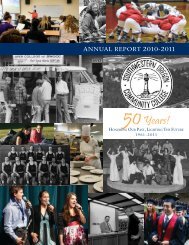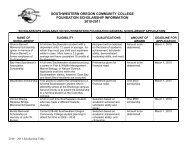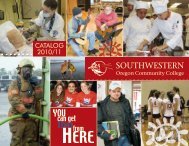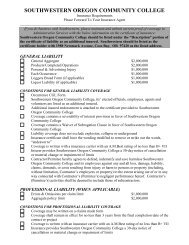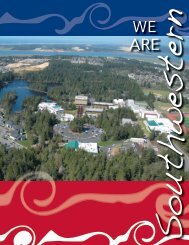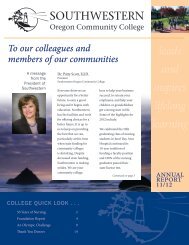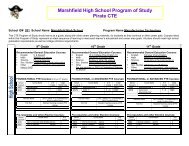Part 1 3.7.qxp - Southwestern Oregon Community College
Part 1 3.7.qxp - Southwestern Oregon Community College
Part 1 3.7.qxp - Southwestern Oregon Community College
You also want an ePaper? Increase the reach of your titles
YUMPU automatically turns print PDFs into web optimized ePapers that Google loves.
Public Safety<br />
Description: A position as a career firefighter is considered one of the most<br />
challenging and dangerous jobs in the United States. Firefighters enjoy a great deal of<br />
job satisfaction (many polls indicate that a career as a firefighter is the most rewarding<br />
job in the United States). Fire science professionals work in residential, industrial,<br />
commercial, medical, airport, rescue, wildland, educational, and regulatory arenas. Fire<br />
science curriculum can include suppression fire fighting, emergency medical services,<br />
specialized rescue, aircraft fire suppression, wildland interface, fire prevention, and fire<br />
marshall inspection.<br />
Employment Opportunities: Fire science positions are among the most<br />
competitive career tracks in the employment market. Firefighters often enjoy higher<br />
retirement benefit levels, and early retirements are often available. Occupational titles<br />
include Recruit Firefighter, Firefighter, Engineer/Pumper Operator, Company Officer,<br />
Chief Officer, Crew Boss, Strike Team Leader, ARFF (aircraft rescue fire fighting)<br />
Firefighter, Fire Marshall, Public Education Specialist, Rescue Specialist, EMT-Basic<br />
through Paramedic.<br />
The Associate of Applied Science in Fire Science Technology program includes<br />
the necessary general education and specialized fire and emergency medical services<br />
courses to prepare students for careers at entry-level positions within the fire service.<br />
This curriculum was developed in cooperation with the <strong>College</strong> Fire Science Advisory<br />
Committee and the <strong>Oregon</strong> Department on Public Safety Standards and Training<br />
(DPSST). Due to continually changing laws and regulations mandated by <strong>Oregon</strong>'s<br />
Occupational Safety and Health Administration (OR-OSHA), DPSST and the National<br />
Fire Protection Association (NFPA), students may be required to add, modify, or delete<br />
courses and/or hours to the curriculum to meet current standards. See your advisor for<br />
current requirements.<br />
Program notes<br />
Associate of Applied Science Fire Science Technology<br />
Notes:<br />
1. Student may substitute SP100 or SP219 for SP218<br />
2. HE250 or three credits of PE185 may be substituted for PE231.<br />
3. PSY202 or PSY203 may be substituted for PSY201.<br />
4. Fire Science specific electives: FS5236, 5239, 5249, 5263, 5279, 5284, 9173,<br />
9318, 9370, 9380, 9390, 9402, 996E, 996I, 996Q, HE258A/931A, HE258B/931B,<br />
HE260/9360 or contact the Fire Science Coordinator.<br />
5. Developmental and remedial courses, listed on page 62, and CS101 and WR121<br />
will not fulfill elective requirement.<br />
6. See Distribution requirement lists on page 63. Courses must be from outside the<br />
student’s area of concentration.<br />
<strong>Southwestern</strong> <strong>Oregon</strong> <strong>Community</strong> <strong>College</strong> 2006-07 Catalog www.socc.edu Programs 132



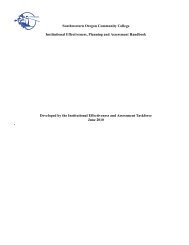
![SWOCC Viewbook [PDF] - Southwestern Oregon Community College](https://img.yumpu.com/26373688/1/190x245/swocc-viewbook-pdf-southwestern-oregon-community-college.jpg?quality=85)
